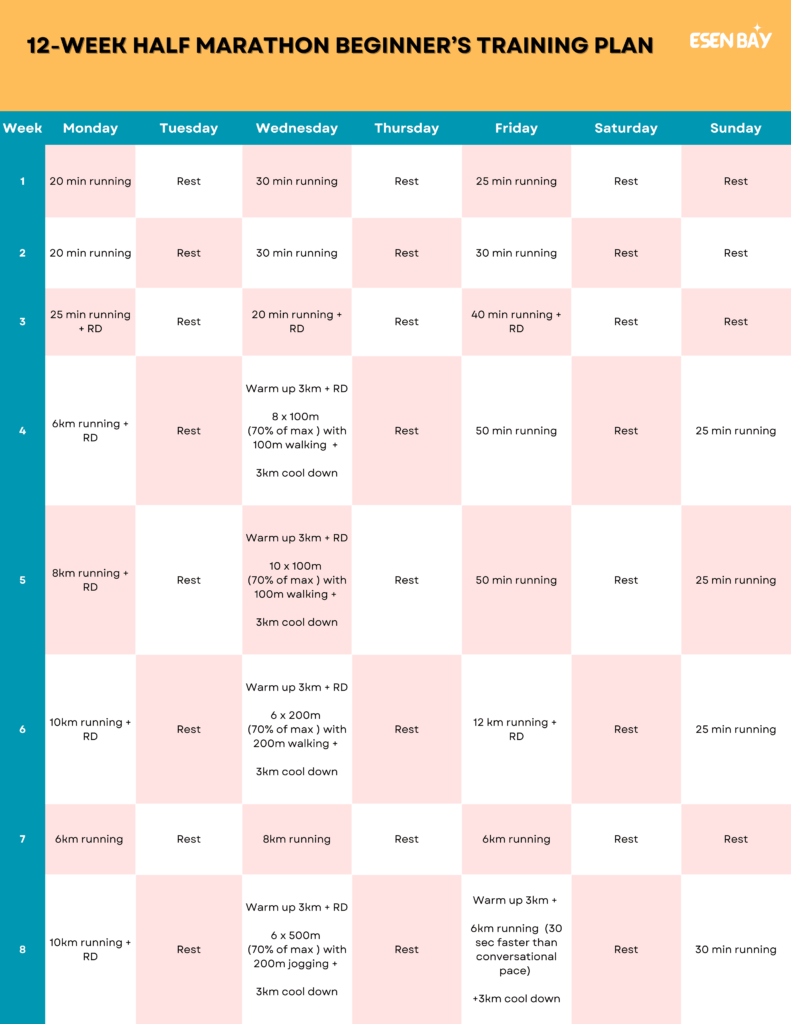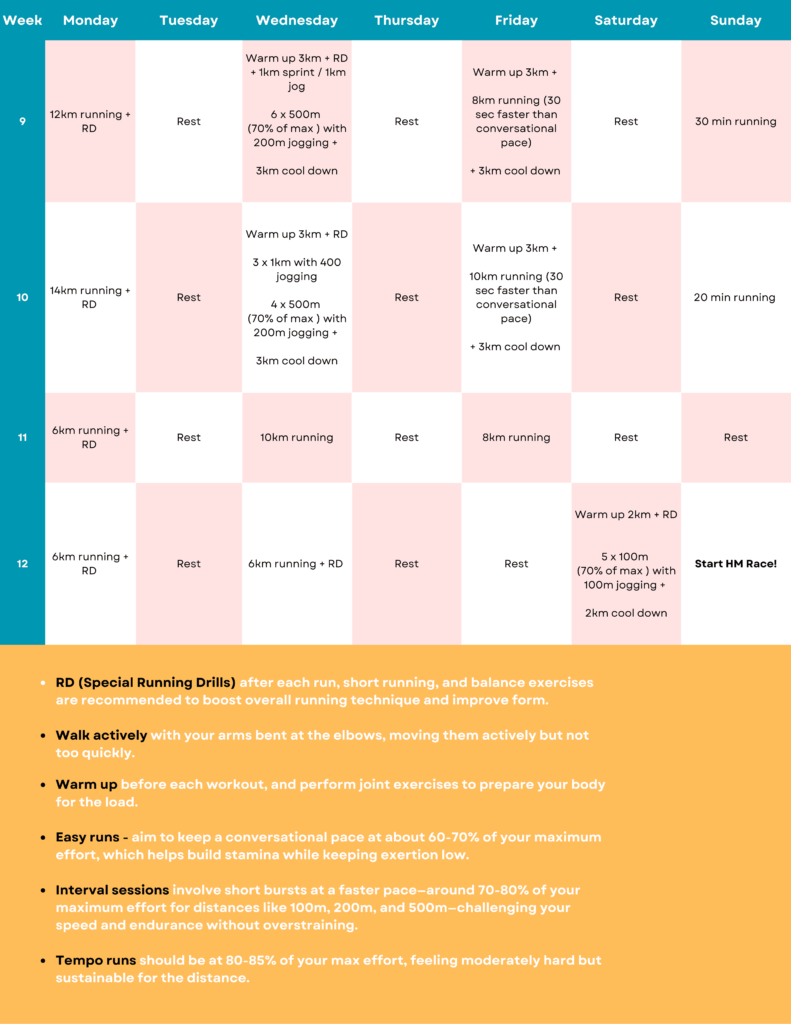Despite the relative popularity of the half marathon, finding a program for this race takes a lot of work. According to many coaches, the program’s structure directly depends on the athlete’s level of training.
For example, let’s take elite athletes who spend about an hour on the half-marathon distance – almost the same time it takes a beginner runner to run a 10 km race.
Likewise, amateurs with a more moderate pace complete a half marathon in close to two hours, the same time elite athletes finish a marathon.
Therefore, training for a half marathon combines elements of training for both a 10 km race and a marathon.
In this guide, we’ll explore the best plan designed by Ilya Tyapkin, a professional and Olympian runner, to find workouts and a realistic target time for the race.
The Training Plan
How Does the Training Plan Work?
The 12-week beginner’s half-marathon training plan is designed to guide you through the preparation process step by step. It balances easy runs, rest days, and targeted workouts to ensure consistent progress and proper recovery.
The first few weeks focus on establishing a routine and building a foundation for running. Short, manageable runs help your body adapt to regular training. As the weeks progress, running drills (RD), longer distances, and interval workouts are introduced.
Long runs are a key feature of the plan. Starting at a moderate distance, they increase weekly to prepare your body and mental endurance for the half-marathon distance (21.1 km).
The plan also includes speedwork, such as intervals and tempo runs to handle faster paces during the race.
Finally, the last two weeks are dedicated to tapering, which allows you to recover and store energy for race day. By following this structured approach, you’ll be ready to run your first half-marathon!
Training Structure Breakdown
Weeks 1–2: Building a Running Habit
The first two weeks are all about getting used to running regularly. Runs are short and based on time, starting with 20 to 30 minutes lasting runs.
Weeks 3–5: Adding Drills and Running Longer
In Week 3, running drills (RD) are added to help you improve your technique. Runs gradually get longer, increasing from 6km to 10km by Week 5. Interval sessions, like short sprints with walking breaks.
Weeks 6–8: Pushing Limits
Now, the focus is on running farther and faster. You’ll do longer runs up to 12km and more challenging intervals, such as 500m and 1km repeats. Faster-paced runs (tempo runs) are introduced to get you used to running at a quicker speed.
Weeks 9–10: Longest Runs and Race Prep
These are the hardest weeks of training, with your longest run reaching 14km. They prepare you for the race as if you are running a real race.
Weeks 11–12: Resting Up for Race Day
The last two weeks are all about resting while keeping your legs active. Runs are shorter and more accessible to make sure you feel fresh. This is called tapering.
By Week 12, you’ll be ready and rested for race day to complete your half marathon!
What Paces Should I Train At?
Training at the right pace is crucial to avoid burnout during your half-marathon preparation. Each type of workout in the 12-week plan serves a specific purpose and requires a particular pace:
- Easy Runs: These should be done at a comfortable, conversational pace, around 50–60% of your maximum effort. You should be able to chat without gasping for air. Easy runs help build your aerobic base and allow recovery.
- Long Runs: Slightly faster than easy runs but still manageable. Long runs focus on endurance, so maintain a pace of 60–70% of your maximum effort.
- Running Drills and Intervals: These involve bursts of speed at around 70% of your maximum effort, followed by slower recovery intervals (walking or jogging). Focus on good form rather than all-out sprinting.
- Tempo Runs: Run at a challenging but sustainable pace—about 30 seconds per kilometer faster than your easy run pace. This pace helps improve your ability to sustain faster speeds over longer distances.
Pace your running using a running app or smartwatch. Adjust based on how you feel, especially on harder days, and always prioritize consistency over speed.
What is a Good Target Time for a Half Marathon?
A “good” target time for a half marathon depends on your fitness level, running experience, and goals. For beginner runners following this 12-week plan, a realistic target time ranges between 2:15 and 2:45 hours. This translates to an average pace of 6:30–7:50 minutes per kilometer.
If you’re newer to running, focus more on completing the distance rather than achieving a specific time.
As you train, long runs and tempo workouts will give you a sense of your comfortable race pace. Use these sessions to estimate how long it might take you to complete 21.1 km. Your target time will become clearer with consistent effort as you progress through the plan.
Setting a time goal below 2:00 hours might be realistic for intermediate or advanced runners. However, this plan is tailored to beginners, emphasizing a steady build-up to ensure a successful race day finish!






